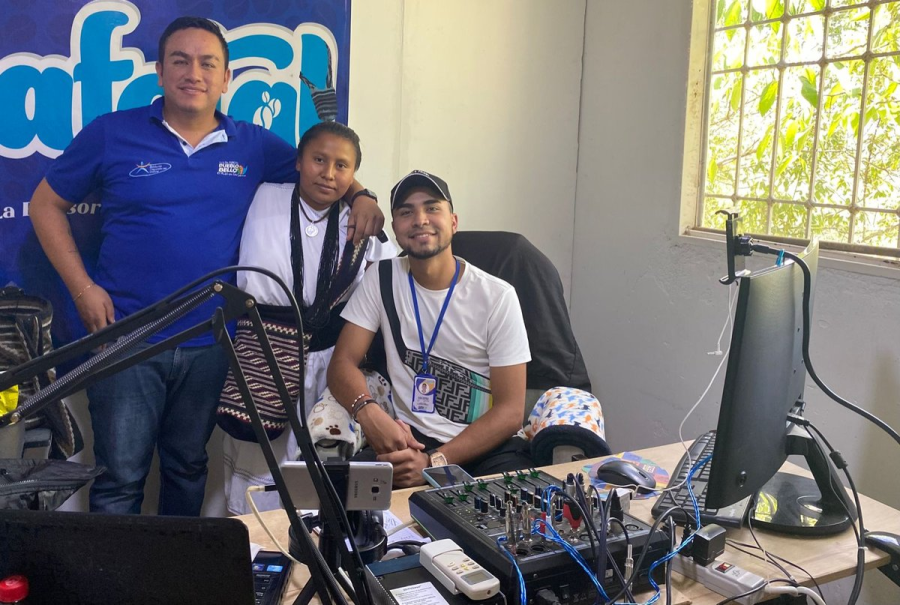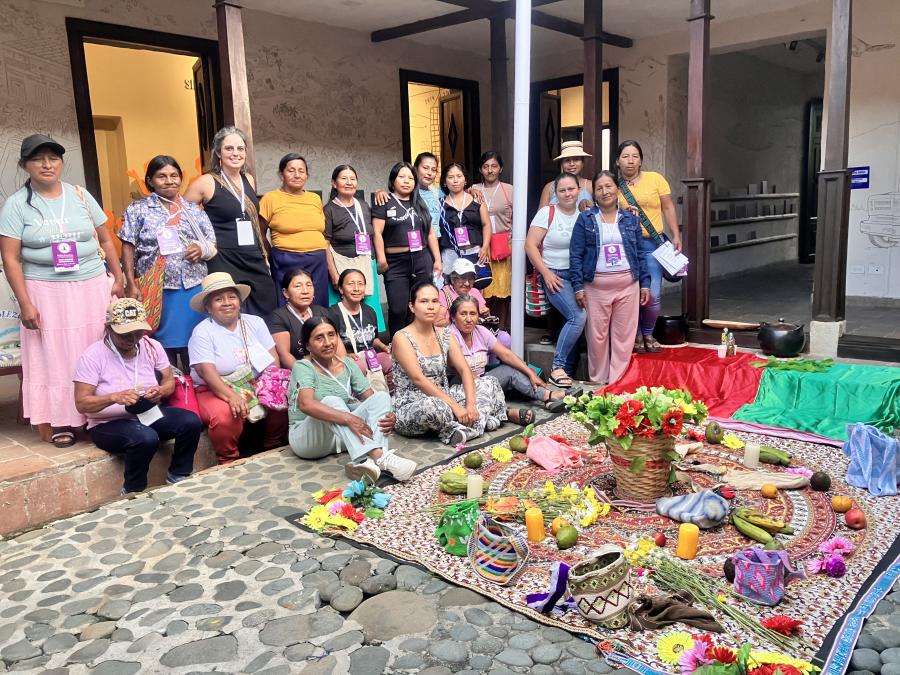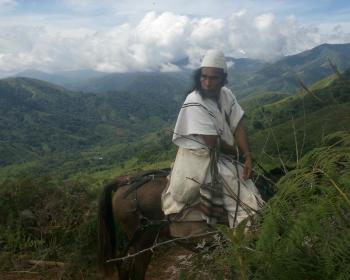The White Man eats coal," said the Guajiro Indian woman, "but neither us nor our animals eat coal, that's not our life." With this statement she underscored the basic incompatibility between the Guajiro notion of well-being and the Western notion of development as embodied in El Cerrejon Coal Mining Project in northeastern Colombia.
This project, a seven billion dollar open pit mining venture of the Colombian Government Coal Co., CARBOCOL, and Exxon's INTERCOR, has generated considerable debate since the late 1970s. In 1982, it became a presidential campaign issue with the controversy even reaching Congress. Politicians, technocrats, journalists, national and local personalities have all contributed to a discussion muffled by the unprecedented size of the investments already underway and the rapid transformation of local and regional socioeconomic horizons.
If the debate has lost its edge, what's at stake remains as controversial as ever. The terms of the contract for the government's joint venture with Exxon are periodically questioned in the press. The unprecedented "exxonerations," and the muddled logic that led decision-makers to select railroad ties and diesel locomotives better suited for Exxon's than Colombia's interests, only highlight the corporate wisdom of "what is good for Exxon is good for the country."
The local criollo (non-Indian) interests, concerns and points of view have had a number of articulate defenders. The Association of Professionals of La Guajira voices the opinions of local university-educated professionals, while the municipal and departmental Chambers of Commerce successfully represent and defend local criollo concerns.
Few, however, have defended the interests of the local Guajiro Indians, in spite of the fact that they might be the most affected by El Cerrejon Project - around 40 percent of the population directly affected by the project is made up of Guajiros. Furthermore, the mining operation not only affects the lands immediately above the mine itself, but bisects Guajiro territory with 150 km of railroad, from the mine in the southwest to the Bay of Portete to the northeast.
The Guajiro were ignored in the planning stages of the project. The socioeconomic studies ordered by Exxon reflect discriminatory and ethnocentric biases which translate into negative effects for the native population. The hasty land negotiations implemented by Exxon's subsidiary backfired at the beginning of 1983 when Indians paralyzed the project by demanding compensation for their land. Today the Columbian government, with its disjointed policy toward Indian lands, is denying legal recognition of the Guajiro and their territory.
In 1977, Universidad de los Andes did the first feasibility study for the coal mining project. This study, however, was merely a review of the literature about the Guajiro. Four years later, in 1981, when construction work for the road and railroad had been under way for a year, INTEGRAL, the consulting engineering firm in charge of the environmental impact study for the project, subcontracted with the National University for a socioeconomic study of the region. The study was headed by two architects with no experience among native populations. Due to methodological and conceptual disputes the research team they formed, heavily dominated by architects, a few economists and some sociologists, never visited the area. A new team, headed by one of the architects, finally went to the region for two weeks but never reached the Indians' territory because they were afraid of the local population, which did not speak Spanish. The study they presented in 1982 was not well received by INTEGRAL, CARBOCOL or the National Planning Agency (DNP). Around that time, anthropologists with experience in the area were contacted to carry out the study but they were never contracted to do it.
In 1983, three full years after the initiation of the project's road and railroad construction work, INDERENA, the government agency charged with approving the impact assessment studies, endorsed what was basically the same study that had been presented the year before. INDERENA does not have the personnel or the funds to properly evaluate such work.
"Any process of development logically does violence to social structures," said Ricardo Plata in a 1981 conference to explain the future of La Guajira, "and," he added, "produces in some cases, if not physical ethnocides, certainly cultural ethnocides." The project Deputy Manager of El Cerrejon was not describing what is inflicted upon minorities in the name of progress or, for that matter, clinically diagnosing the death of a people. Regrettable as it may be, and to the disbelief of those in the audience, the high-ranking official was stating the de facto policy of the coal concern toward the Indian population in the area.
In the logic of this technocrat ethnocide is just one of those unavoidable costs attached to any process of development. There is little or no purpose in mitigating or compensating the local indigenous populations for a project that will bring "development." As a result, social impact assessment studies on Indian people in Colombia are stillborn. What should be a means to channel and shape the social responsibility of the government has become in practice a formal exercise in futility. Native populations have no possibility of receiving the institutional protection written into the law and there is no way of defining proper measures that compensate for and mitigate the negative impact of hydroelectric or mining projects on the native population. What is probably more alarming is that even if the studies had been done properly there would have been very little point in submitting them three full years after the construction phase had been initiated.
This situation has already produced confrontation at a local level between the affected Indians and the construction companies along the railroad. No systematic provisions for the native population have been made and the future for the Guajiro does not look very bright. Nevertheless, in October 1982, YANAMA, the Guajiro Indian organization, was created to gather together as many local indigenous groups as possible, evaluate their present condition, and define their course of action. So far YANAMA has successfully carried out a number of activities, including a series of intercultural bilingual education courses for Guajiro primary school teachers. Charcoal producers and salt mine workers have created their own organizations and the struggle for land has become a long-term commitment.
Only in the last 10 to 15 years have the Guajiro experienced major land struggles in their ancestral territory. Their concern is not just born of the recent underhanded corporate manipulation of the land negotiations between El Cerrejon Project and the Indians, but out of increasingly violent confrontations with large landholders and settlers in the southwest of their territory.
Pressed by YANAMA's demands and with the momentary support from the local government, the national government undertook feasibility studies to create a resguardo (reserve), the best juridical form available under Colombian law to protect Indian lands. By June 1983, all necessary documents were submitted to INCORA, the Colombian land title-granting agency. In January 1984, the reserve had not been created, allegedly because no funds could be mustered for the ethnodevelopment plans devised for the reserve. This argument, with its "progressive and realistic" understanding of the institutional forces and what the land means for the future of the Indian communities, has been advanced by INCORA, but also by the Colombian Institute of Anthropology. According to the law, such financing is not a prerequisite for the constitution of reserves; thus, the delay on these grounds is illegal. International pressure might prove effective both in finding monies for the ethnodevelopment programs and in obtaining legal recognition for the collective ownership of the Guajiro ethnic territory.
Beyond the legal squabbles, El Cerrejon Project is there to stay. The size of the investment, the political will of the national government and the transnational's concern guarantee it. Its effects on the local Indian population are already being felt.
The project's infrastructural investment which has had the most impact in La Guajira is the road that runs parallel to the railroad strip. Due to its sheer magnitude, it represents a substantial improvement in the local infrastructure. It is, without question, the single factor which will most affect the local population.
Transportation has been improved to the extent that this road reduces travel time and improves travel conditions and reduces costs. In the short term food costs will be reduced, an unquestionable benefit for the local population, which up until now was forced to buy expensive food in Uribia, one of the two non-Indian settlements in the territory or in Maicao where high transportation costs could only be offset by bulk purchases.
Another benefit from this road is that transportation will now be more reliable during the rainy season, a time when unusually abundant rains could isolate the region for weeks and cause the food supply to disappear.
Not all the consequences of the road are positive, however. The road and, more so, the railroad, will disturb the movement of humans and animals from one side of the territory to the other. The daily movement of herds to watering places and the long migrations during the dry seasons will be disrupted. Officials from the project have assured the local government's Bureau of Indian Affairs that any community cut off by the railroad from water sources, pastures and other resources will have a special access road. No additional compensation has been suggested.
Furthermore, improved transportation in the region has brought many visitors. As elsewhere, the impact of this new situation has to be evaluated not only in terms of the visitors' economic contributions to the local economy, but in relation to their impact on the local population and the local resources. Regarding the former, plans for intensified tourism in the area have been circulating in government and private circles. Grandiose plans have led to the creation of an 18,000 hectare tourism reservation carved out of Indian lands along the coast. Needless to say, the local Guajiro do not know this. In spite of a promising start, since the land was taken for nothing, little has been said about the economic feasibility of such plans or the fact that water shortages are endemic to the area. The fact that a hotel complex requires large amounts of water to operate is totally ignored. The few who understand this technical problem remain blinded by the image of a smokeless industry.
Tourism industries seem to generate a very limited local benefit beyond a few service jobs, a short term construction spree and some prostitution. Planners seem to ignore that tourism, when not controlled locally, introduces a number of distortions in the local economy which alter expectations and patterns of consumption in the native population, not to mention corruption or delinquency.
The Guajiro urban experience in Maracaibo is a good indication of the results of intensified contact with the larger society. The proportionally higher ratio of delinquency and crime found among the urban Guajiro underscores the cultural and socioeconomic maladjustments which accompany this process of incorporation, "civilization" and development. Guajiro authority, traditionally in the hands of elders, is undermined, along with fundamental values and ideas of their society. The process of urbanization also affects local institutions for payments and exchanges, mediators and representatives of the lineages, collective property and responsibilities, etc. In Maracaibo the intensified contact between the semi-nomadic pastoralist Guajiro and the industrialized urban criollo is associated with a remarkably high incidence of mental disorders among urban Guajiro.
An ecological consideration should make those who advocate fur "development" think twice about their proposals for the Peninsula. This has to do with the regional impact of the road. It is important to remember that increased vehicular traffic in semi-desertic and desertic environments seriously deteriorates their fragile ecology, as demonstrated by the motorcycle and dunebuggy traffic in parts of California and the southwest United States.
Another environmental impact is the coal dust contamination along the railway. Predictably, this will occur on the leeward side of the road; the constant wind and sun dry out the five percent humidity added to the ground coal at the mine. The dust will fly off in a 150 km trek to the port. It has been estimated that, if, as originally planned, train carts are not properly covered, at the end of the first year of operation a two-kilometer black strip will be visible along the railroad, and most plant and animal life in that strip will be eliminated. Certainly the Indian population will be endangered; yet, no warnings have been issued to the local population.
The environmental impact will not be limited to land. The large-scale dredging necessary for the deep sea port has already produced devastating effects on plant and animal life at sea. Native fishing has been affected along the coast from the port site to Cabo de la Vela in the southwest. This situation will not improve once the construction phase is over since thermic and other pollution from the huge coal ships mooring and anchoring in the area will be emitted.
Elsewhere, at the mine site and at other coal project sites, the demand for fresh water is taxing the limited underground water supplies available in the area. Little, if any, concern has been shown by the government or Exxon regarding the negative effects that this decrease in water supplies will have on the waterholes and water sources used by the Guajiro. The very basis of livelihood for the ancestral inhabitants of the Peninsula is being imperiled. In fact, recently El Cerrejon Coal Project asked for special licenses to use the underground water in the area. Since the permit is issued by the same agency that approved the environmental impact assessment, it is likely that the decision to grant such a permit will not take into consideration the local population's needs or desires.
The environmental protection agency (INDERENA) approved land use and coal mining for El Cerrejon Project in a number of areas within Indian territory without consulting the local population. The project thus "acquired" additional rights in the ethnic territory beyond the port site and railroad strip lands. One of these additional land grants is the mountain of Epits (Cerro de la Teta), a mythical character who travelled the Guajiro territory along with his two brothers. This important mythological landmark of the Guajiro is to be used as filling for the railroad. Guajiro leaders from different parts of the Peninsula have protested such acts, but it is uncertain what will happen. Numerous other generous land grants have been created by the government at the expense of Indian lands in the Peninsula.
The official justification for El Cerrejon Project, beyond the creation of foreign exchange, is that jobs will be generated for local residents. These, of course, are for the area's non-Indian population. As far as the local population is concerned, this is not a strong argument. Uribia, in the heart of the Guajiro territory, has had less than favorable experiences with this sort of development project. Even in the good days, when the government invested in water programs in the area, and more than 500 local workers were trained in the use of machinery, maintenance, welding, windmill repair, etc., this labor force, subjected to a high job rotation common under harsh working conditions, and facing a limited job market, eventually did not find work in the area and had to leave, either to Maicao, other towns to the south, or to Venezuela.
This experience discredits the much-praised training programs launched by the government's vocational training agency (SENA), and the on-site training with the construction companies in the project. It can be expected that, once the construction phase is over, the pattern of labor migration will be repeated. The project has been conceived as an enclave enterprise which will employ 4,000 workers; thus half of the 8,000 people presently working will be jobless at the end of the six-year-long construction phase.
The El Cerrejon Coal Project, as it is designed and being implemented, will not improve the living conditions for the Guajiro. The payment of royalties could perhaps compensate the local population, in part, for the negative impact of this venture in their lives, their society and their environment, but to date the issue of royalties has not been raised.
Due to circumstances which include the growing pressure from YANAMA and other local indigenous groups, the Department of La Guajira embarked on a planning project which included, for the first time in the history of the local administrations, an ethnodevelopment plan specifically designed for the Guajiro Indian population. This plan, as mentioned at the beginning, was based on a document elaborated by YANAMA, the Guajiro Indian organization in the ethnic territory. At the local level, such government support established a new precedent for the Indian cause, but it has elicited mixed responses from different national government agencies.
It is unlikely that any new policy will emerge. The traditional lack of continuity in the local government programs, the deeply rooted ethnocentrism and lack of respect for Indian people, the latter's limited and subordinate participation in the political life of the national society, all point to a future in which little if any significant government support will be available for plans and initiatives from the Guajiro.
In spite of this grim picture, the present situation has already generated solidarity within the Guajiro society, and it is possible that ethnic identity will be strengthened in the continuing struggle. In addition, much needed external support could mitigate the more adverse effects of El Cerrejon Project on the Guajiro. Legal recognition and protection of the ethnic territory plus support for the various ethnodevelopment programs are their first priorities. National and international support to this effect will be most welcomed. Letters of support should be sent to:
* Senor Gerente General, INCORA, CAN, Bogotá, Colombia
* Senor Ministro de Gobierno, Calle 13, No. 8-38, Bogotá, Colombia
* YANAMA, Apartado 450, Maicao, Guajira, Colombia.
Article copyright Cultural Survival, Inc.



